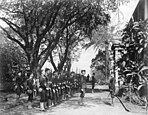Wallene Civil War
| Wallene Civil War | ||||||||
|---|---|---|---|---|---|---|---|---|
| ||||||||
| ||||||||
| Belligerents | ||||||||
|
|
| ||||||
| Strength | ||||||||
| 24,000 | 30,000 | 18,000 | ||||||
| Casualties and losses | ||||||||
| +10,300 | +19,500 | +10,500 | ||||||
The Wallene Civil War; Wāladoárà Civél pā Wālolénlòhátoà in Olílò and Guerra Civil da Wallenlândia in Qoati, was a civil war in Wallenland between the Liberals and Conservatives and other groups.
Various factors played into the civil war however the main factors were the succession crisis in the monarchy after Dáldòpābaguò's death, question of industrialisation, Wallene independence and nationalism, and the powers of the monarchy.
The dissolution of the CIIEQ and the subsequent Second Wallene Wars brought tensions between Koàsoàwúŕata pā Wālolénlò, the Quetanans, and the fajògo: Valhókoà-zā-oapagà zā Láhà'adada, Frederico zā Wāladoárà, Olílò zā Hátoàlām, and Paulinho pā Baguò'úŕato who had organised themselves into the 'Council of the Chiefs', even after the signing of the First Constitution of the Dominion Koàsoàwúŕata felt by the chiefs, preventing his visions for Wallenland. Upon Koàsoàwúŕata's death in 1888, his first son Bàlām pā Wālolénlò took over the throne and began drafting a second constituition without consideration from the chiefs. With the exposure of Bàlām's draftings and intentions, the chiefs immediately gathered armies and threatened Bàlām and wrote to Quetana over the "threat of constitutional order". Bàlām refused to withdraw his draftings and gathered an army of his own from Wallenland, hiring foreign mercenaries, and even garnered support from Wallene Islamic leaders such as the Imam Mohammad Reza Omar Fazel and groups with grants and further political and religious power. Bàlām's forces met Hátoàlām's and Baguò'úŕato's forces at Fort Santo Agostinho - beginning the First Constitution War, however several conflicts sprung up between the monarchy and the chiefs over many other reasons, including the constitution.
...



